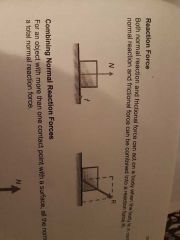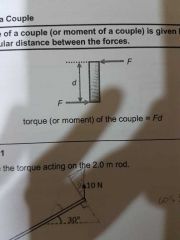![]()
![]()
![]()
Use LEFT and RIGHT arrow keys to navigate between flashcards;
Use UP and DOWN arrow keys to flip the card;
H to show hint;
A reads text to speech;
11 Cards in this Set
- Front
- Back
|
Weight, W |
It is the gravitational force that the Earth exerts on a body. |
|
|
Tension, T |
It is the force that a string exerts on the body that the string is attached to. |
|
|
Normal reaction, N |
It is the force that acts on a body when the body is in contact with a surface. |
|
|
Friction, f |
It is the force that acts on a body when the body is in contact with a rough surface. |
|
|
Reaction Force |

Both normal reaction and frictional force can act on a body when the body is in contact with a rough surface. The normal reaction and frictional force can be combined into a reaction force R. |
|
|
Conditions for Eqm |
1) The resultant force acting on the body is zero. This ensures translational eqm. 2) The resultant torque acting on the body is zero. This ensures rotational eqm. |
|
|
Moment of a Force |
The moment of a force about an axis is defined as the product of the force and the perpendicular distance btw the axis and the line of action of the force. t = F × d t - moment or torque (Nm) F - magnitude of the force d - perpendicular distance btw the axis and the line of action of the force (m) |
|
|
Torque of a Couple |

The torque of a couple (or moment of couple) is given by the product of one of the forces and the perpendicular distance btw the forces. torque (or moment) of the couple = Fd |
|
|
Principle of Moments |
The principle of moments states that if a body is in eqm, the total clockwise moment about any axis is equal to the total anticlockwise moment about that axis. |
|
|
Concurrent Forces |
When a body is in eqm and there are 3 forces acting on the body, the lines of action of the 3 forces will intersect at a common point. If the lines of action of the 3 forces intersect at a common point, we say that the forces acting on the body are concurrent. |
|
|
Hooke's Law |
Hooke's law states that the force is directly proportional to the extension in a spring or wire if the limit of proportionality is not exceeded. F = kx elastic potential energy: U = 1/2Fx = 1/2kx^2 |

